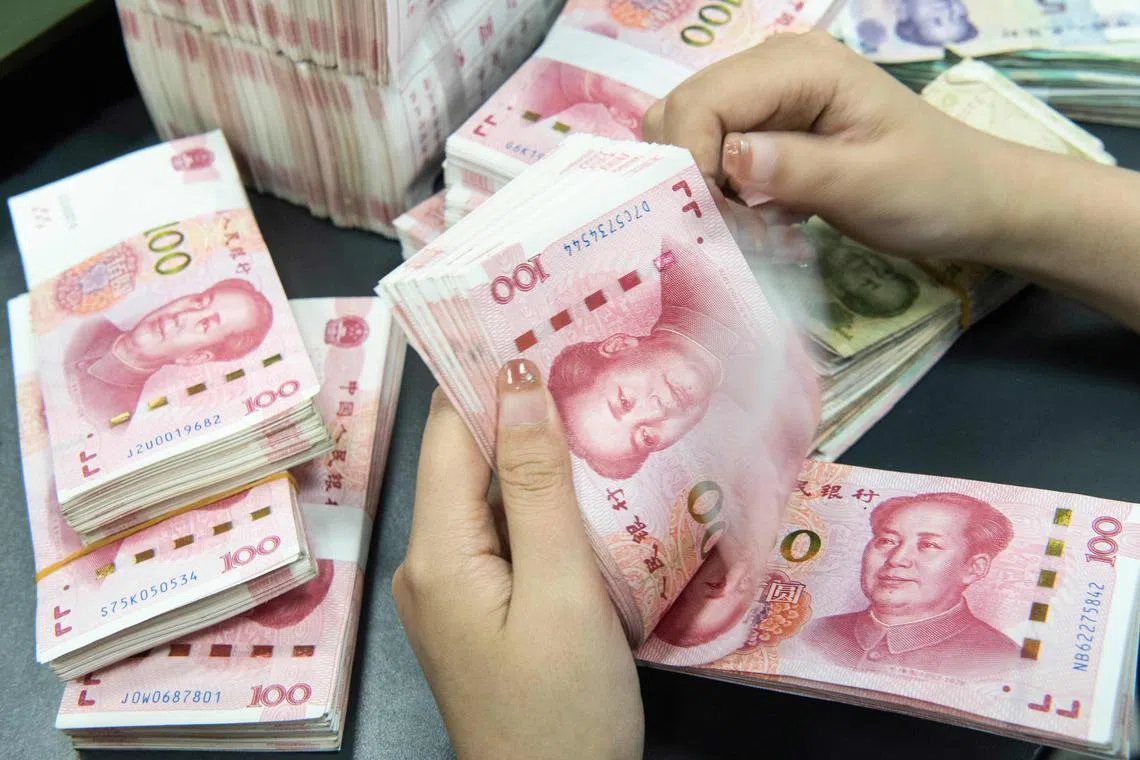Savers in China trek hundreds of kilometres for higher bank deposit rates
Sign up now: Get ST's newsletters delivered to your inbox

The elaborate lengths taken to boost savings rather than spend cash is yet another blow to Beijing’s desired consumer-driven recovery.
PHOTO: AFP
Follow topic:
SHANGHAI - Meticulous planning, in-depth research and long-distance travel – welcome to the “special forces-style” hunt for the best bank deposit rates in China.
As commercial lenders in the nation lower rates on a range of deposit products, young Chinese are working hard to track down the highest returns for their money.
Take Mr Dan Chen, who in May made a 270km return train trip from Shenzhen to neighbouring Guangzhou to deposit one million yuan (S$186,700). The 34-year-old clothing wholesaler and factory owner will make about 40,000 yuan more in interest over three years than if he had used his local bank.
Ms Melody, a 31-year-old headhunter in eastern Wuxi, made a 260km journey to Shanghai in both May and June to deposit around 500,000 yuan.
The elaborate lengths taken to boost savings rather than spend cash are yet another blow to Beijing’s desired consumer-driven recovery.
In many countries, finding the top deposit rate is as simple as using a price comparison website, but in China the process is more protracted.
While commercial lenders post their nominal rates on their websites, in practice even branches of the same bank often offer different rates and incentives across cities, leaving room for arbitrage.
For customers, the hunt involves checking out banks’ promotional information on social media, consulting friends and ringing up or visiting account managers at various lenders.
Now, “special forces-style travel” – a recent phenomenon in the nation where people take short, intense holidays with a packed itinerary to minimise costs and maximise experiences – is being adopted to fit the chase for higher deposit rates.
Young people are using the low-cost, high-return mantra of the travel style to plan whistle-stop trips that deliver a solid return on their money.
Turning to savings
While young Chinese typically prefer higher-yielding options like stock funds, the sluggishness in the world’s second-largest economy
The benchmark CSI 300 index has dropped more than 25 per cent over the past two years, among the worst performing globally, while real estate, where about 70 per cent of household fortune is tied up, is no longer a sure-fire bet to build wealth given a crackdown.
Like the wallet-friendly special forces-style travel, the trend to hunt for the best deposit rate risks hindering consumer spending.
China’s household deposits hovered near a record 130 trillion yuan as at May, while the central bank’s recent survey of urban depositors suggests more people are seeing their incomes dropping and are inclined to increase their savings.
On Xiaohongshu, a popular social media platform where users often post fashion and travel tips, people are increasingly sharing and looking for tricks to get higher deposit yields.
A search on the app for “deposit” and “savings” will return more than two million posts combined.
“This just shows how pessimistic people are towards their income growth prospect and that’s why they’re spending more time trying to find other options,” said Mr Shen Meng, a director with Beijing-based investment bank Chanson & Co. “When it comes to consumption, the mindset of most people is to save up to fend against bigger uncertainty in future.”
For Ms Melody, it was worth the hassle: One bank offered her 3.5 per cent annualised interest on a three-year deposit, compared with 3.1 per cent from the same lender in Wuxi; the other sold her a deposit product at 3.55 per cent. For comparison, the big five state-owned banks paid only 2.6 per cent and 2.45 per cent in nominal rates on three-year deposits before and after their latest reduction.
Mr Chen from Shenzhen was offered more than 4 per cent for his three-year deposit at the Guangzhou lender.
Hidden risk
China’s smaller lenders typically offer preferential interest rates on deposits to win over customers from bigger peers.
But they may soon follow their larger rivals and cut rates to ease margin pressure, leaving less room for deposit rate arbitrage.
Consumers also risk losing part of their money if the bank where they deposit it collapses, as China’s deposit insurance scheme covers only up to 500,000 yuan.
The nation’s regional and rural banks have lent heavily to uncompetitive local companies and government pet projects, leading to non-performing loans and making them a weak link in the financial sector. In May 2022, an alleged multibillion-dollar scam at some rural lenders triggered violent confrontations in Henan province between local police and protesters demanding their money back.
Some people appear undeterred.
A Xiaohongshu user flew to Guizhou from Shanghai in mid-June to deposit more than 500,000 yuan for five years with an annualised rate of 4.5 per cent, according to their post. “Don’t tell me small banks could go under, I won’t listen to that.”
For others like Mr Chen, who is cutting back on expenses and delaying expansion at his factory given the economic headwinds, savings are the only safe bet.
“I don’t have confidence the situation will change much in the following years,” he said. “The best choice currently is to put my money into the bank and get a relatively high interest rate in the rate-cut cycle.” BLOOMBERG

